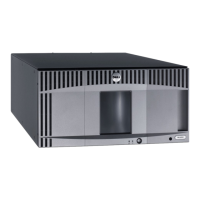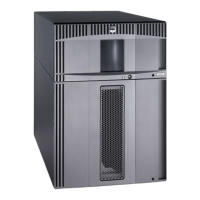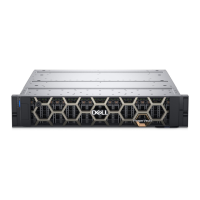Advanced Reporting
file:///T|/htdocs/stor-sys/ML6000/en/html/ch04_AdvRpt.htm[9/17/2012 1:49:37 PM]
Back to Contents Page
Advanced Reporting: Dell™ PowerVault™ ML6000 Tape
Library User's Guide
About the Advanced Reporting License
Working With Advanced Reporting Reports
Configuring and Viewing the Media Security Log
Viewing the Media Usage Log
Automatically E-mailing Advanced Reporting Reports and Logs
Advanced Reporting is a licensable feature. You must have an Advanced Reporting license installed on your library in order to
use the features described in this chapter. For more information on licensing, see
Obtaining and Installing a License Key.
Advanced Reporting provides the following reports that you can configure, view, save, and e-mail:
• Drive Resource Utilization Report — Provides tape drive usage information, showing you which tape drives are
working at optimum capacity and which are under-utilized. This can help you allocate your tape drive resources
properly.
• Media Integrity Analysis Report — Provides TapeAlert count for various combinations of tape drives, tape
cartridges, and TapeAlert flags. This can help you determine if a problem is due to a specific tape drive or tape
cartridge.
Advanced Reporting provides the following logs that you can view, save, and e mail:
• Media Security Log — Lists media that has been removed from the library.
• Media Usage Log — Lists information on all media that have ever been in the library.
In addition, you can automatically e-mail any of the reports and logs to designated recipients at specified, scheduled times.
Note: To use all the features of Advanced Reporting, your library firmware must be at version 580G or higher.
About the Advanced Reporting License
The Advanced Reporting license applies to your entire library, regardless of library size. This means you only need to
purchase the license once. If you increase the size of your library, your existing license applies to your new library
configuration.
Working With Advanced Reporting Reports
Details about Advanced Reporting reports include:
• The data for the reports is collected in log files. When the log files reach their maximum size, the oldest information is
deleted as new information is added. This may affect how much historical data you can access.
• The on-screen reports contain a chart and a data table. When the log files are large, it would take an excessively long
time to load all the historical data into the data table. For this reason, the table displays a maximum of 1000 rows of
data, beginning with the most recent, even if more data is available. (The graph displays information for the entire
range.) To view all of the data, you need to save or e-mail the data file. See
Saving and E-mailing Report Data Files.
• The reports are built according to data in the log files, not your current library configuration. For this reason, your
library may contain tape drives or cartridges that do not show up in the report. Similarly, the report may contain tape
drives and cartridges that no longer reside in the library.
• Information about a tape drive, cartridge, or operation is not recorded in the Drive Resource Utilization log file until
after a tape cartridge has been mounted (loaded) and unmounted (unloaded) from the tape drive.
Configuring the Drive Resource Utilization Report

